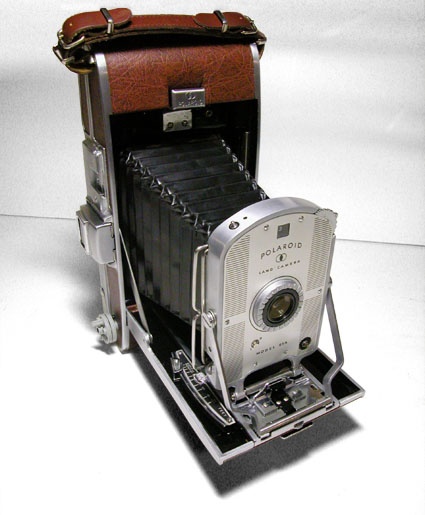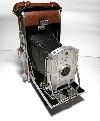Polaroid 2008: Instantly Fading Picture
Creative Company Collapsing From Lack of Vision
By: Mark Favermann - Feb 18, 2008
Overlooking the Charles River about midway between the campuses of MIT and Harvard, there is a wonderful streamlined Art Deco building on Memorial Drive in Cambridge, Massachusetts. For several decades this building was the headquarters of the Polaroid Corporation. The building now houses another high technology firm. This building can serve as a metaphor for the Polaroid Corporation itself: where it once was, new technology has replaced it.In 1973, Polaroid's founder Edwin Land (1909-1991) was heralded as a genius for inventing instant photography. He probably was. With his very slick, iconic SX-70 camera, he was on the cover of Life Magazine and Time Magazine. Unfortunately, there was no one who could take over for him. A very smug corporate culture seemed to takeover instead. In the late 70's-early 80's, Polaroid started to work on its own parallel instant technology to videotape. It was called Polavision. As far as I can determine, it was some sort of an instant hybrid of Super 8 film. It flopped mightily. Things have spiraled downward for Polaroid ever since.
Recent articles have reported that The Polaroid Corporation is stopping production of its instant film. Not only is it laying off 450 employees worldwide (150 in Massachusetts), it is sending "the horse that brung 'em" to the glue factory. Polaroid's brand to consumers literally meant instant photography. Now what will the brand mean?
Several years ago (2000), I did a very positive article on the company for a regional publication. Polaroid was at a financial and product crossroads then. I guess that I was still enamored with Polaroid's corporate myth and legend. Artistic types like me are often impressed by new technologies. I was wrong to be such a cheerleader then. I had several interviews with various staff and consultants. Though I don't remember it, I may have even drunk their Kool-Aid. The various Polaroid designers, in-house and hired guns, all told me about the future-perfect greatness of the company and its brand. Perhaps, I have learned my lesson finally: generally, seventy-year-old high tech companies may have outlived their shelf life. Perhaps, Polaroid Corporation has just become a bit old fashioned and somewhat technologically obsolete?
The best thing about my long ago bar mitzvah was the wonderful gift that my parents gave me—an incredibly sophisticated gift, a Polaroid Land camera. It was an industrial design marvel, elegantly sleek with a futuristic look. The instant pictures were smaller than the wait-for Kodak snapshots, and they had to be immediately covered with a vile smelling coating to make the images more or less permanent. There was certainly a artistic resonance between me and the legendary story of founder Edwin Land's creative answer to his daughter's vacation plea for instant vacation photos—the "miracle" of instant gratification photography.
I do remember, however, that the miracle was not always miraculous. Rarely did all of the attempted images come out as meaningful snapshots, but somehow the Polaroid Corporation got a pass on this somewhat costly disparity. Out of techno-paranoia (perhaps we did not wait the right amount of time to peel the picture from the development sheet?) or just suspension of disbelief (no one gets 8 pictures out of a pack of film), consumers thought this lack of full product usage was somehow our own technologically klutzy fault and not that of the geniuses at Polaroid. This Polaroid legacy of technical superiority lived on in the minds of most Baby Boomers like me until digital cameras started to proliferate. How soon we forget old technologies. Remember VCR's, Betamax, and even all day messages on fax machines?
Over the years, I met many people who worked for Polaroid. It was a major corporation. Some were very nice people; many were arrogant twits. Almost all were extremely confident in the corporate ethos and vision. When Mr. Land died, the vision seemed to get totally diminished. Eventual bankruptcy and a buyout led to a lot of very angry, hurt and generally pissed off former smug employees. Polaroid is now dropping the technology it pioneered long before digital photography rendered instant film obsolete. The instant pictures seemed to continue to appeal to a shrinking consumer base: a few nostalgia buffs, a scattering of professional photographers and those quirky individuals who just liked the now old fashioned instant picture technology.
According to Tom Beaudoin, the current president and COO/CFO of Polaroid, the brand synonymous with instant images will focus on new ventures, such as a portable printer for images from cell phones and Polaroid-branded digital cameras, televisions and DVD players. This year's plant closures and layoffs will leave Polaroid with 150 employees at its Concord, MA headquarters and in nearby Waltham, down from peak global employment of nearly 21,000 in 1978. Quietly, the company stopped making instant cameras over the past two years. Beaudoin says Polaroid is trying to reinvent itself so it lives on for the next 30 to 40 years. There will be a need for a lot of reinvention in the 21st Century.
Strategically, Polaroid failed to embrace the digital technology that has transformed photography. For far too long, it instead stuck to its rather self-absorbed belief that many photographers who didn't want to wait to get pictures developed would hold onto their old Polaroid cameras. This was in the face of the fact that global sales of traditional camera film have been dropping about 25 percent to 30 percent per year in the last decade. Surely, instant film has been falling as fast if not faster. As a privately held company, Polaroid has not disclosed financial details about its instant film business. So, numbers are not available. Apparently, Polaroid instant film will be available in stores through next year. Then, Japan's Fujifilm (FUJI) will actually be the only major maker of instant film in the world.
In the hope that another firm will continue to make the film to supply Polaroid camera enthusiasts, Polaroid is supposedly seeking a partner to acquire licensing rights for its instant film. Currently, the company does seek to gain a foothold in the growing 21st Century digital photography market. Yeah, but that was what they thought that they were doing a decade ago as well. This year, Polaroid plans to sell an 8-ounce photo printer that will be slightly bigger than a deck of cards. It will require no ink and will print business card-sized pictures. It uses thermal printing technology from Zink Imaging, founded by a private investor group who bought technologies from Polaroid as it was coming out of bankruptcy. It is unclear to me who the market will be for this product. Perhaps, kids?
Polaroid also has its brand name on a plethora of foreign-made TVs, DVD players, digital photo frames, cameras and MP3 music players. These are not cameras, however, and other than the logo have no real brand affiliation. Those products supposedly generated nearly $1 billion in revenue last year for Polaroid's parent firm. I am not sure what that means, however.
Polaroid's overall revenue from instant cameras, film and other products peaked in 1991 at nearly $3 billion. It was a public company then, so numbers were published. A decade later, the company went into bankruptcy in 2001 and was bought four years later for $426 million by Minnetonka, Minn.-based consumer products company Petters Group Worldwide. This leads me back to the story that I wrote in 2000, before the bankruptcy and before the buyout.
At the time in 2000, the I-Zone product line, a gadget camera that was geared to preadolescents that produced postage stamp size images, was the highest selling camera product in the United States. But as I observed at the time, this apparently home run product caused a certain conundrum in the company. The problem was that a serious research and development based high technology company founded upon heroic breakthrough discoveries, elegant design, state of the art packaging and at times brilliant marketing was being led by a toy-like even faddish product. Even in the year 2000, when instant photography already meant digital cameras and advancing software technology, the question I asked then was: Where was the Polaroid Corporation actually going?
At the time, the short answer that I was given by the then overly hopeful designers was "Advanced digital technology with great design." Working to solve the problem then was industrial designer and design manager David Laituri. He is currently Director of Product Development at Brookstone in Merrimac, NH. With a long and rather prominent corporate background (Apple, Nike, GM, etc.), he was also a principal with Design Continuum in West Newton, MA. Prior to joining Design Continuum, David held the position of Director of Industrial and User Interface Design with the Polaroid Corporation from 1999 to 2002, where according to his bio, "he helped to solidify the company's brand strategy and successfully bring it to market in products including the Polaroid One." If you say so, Dave.
In 2000, he was rather ebullient about what he was doing at Polaroid. I am sure that he and graphic designer Steven Smith worked very hard and enthusiastically at re-branding Polaroid's then current and emerging products. However, even fighting to have the various sales staff, product managers, designers, engineers and administrators buy into the re-branding design was ultimately just not enough to save Polaroid. At the time, in a myopic Dodo bird way, the Polaroid corporate leadership wanted Polaroid to produce and sell digital cameras. Somehow, Polaroid was to become Nikon or Canon or Olympus. It didn't or couldn't. And it was just too late. The best laid plans, etc.
Design is a funny business. Despite what some designers may think, there are often too many factors to predict exact outcomes. Laituri's rebranding was probably well-implemented. But, here, the operation was a success, but the patient died.
Before there was high tech, there was the Polaroid Corporation. It was part of American 20th Century pop culture. It was part of American technological history. Now, Polaroid is at another crossroads. One 21st Century road may lead to continuation of one of the great American corporate icons; the other road may lead to brand oblivion.



